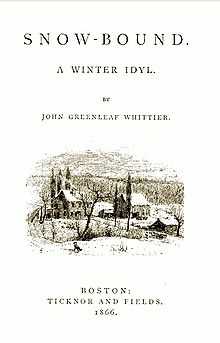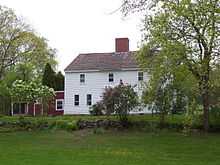Snow-Bound

Snow-Bound: A Winter Idyl is a long narrative poem by American poet John Greenleaf Whittier first published in 1866.
Overview
The poem takes place in what is today known as the John Greenleaf Whittier Homestead, which still stands in Haverhill, Massachusetts.[1] The poem chronicles a rural New England family as a snowstorm rages outside for three days. Stuck in their home for a week, the family members exchange stories by their roaring fire.
Composition and publication history

Whittier began the poem originally as a personal gift to his niece Elizabeth as a method of remembering the family.[2] Nevertheless, he told publisher James Thomas Fields about it, referring to it as "a homely picture of old New England homes".[2] The poem was written in Whittier's home in Amesbury, Massachusetts,[3] though it is set at his ancestral home in Haverhill.[4] Snow-Bound was first published as a book-length poem on February 17, 1866.[5]
Response

Snow-Bound was financially successful, much to Whittier's surprise.[6] By the summer after its first publication, sales had reached 20,000, earning Whittier royalties of ten cents per copy. He ultimately collected $10,000 for it.[7] Its popularity also led to the home depicted in the poem being preserved as a museum in 1892.[8]
The first important critical response to Snow-Bound came from James Russell Lowell. Published in the North American Review, the review emphasized the poem as a record of a vanishing era. "It describes scenes and manners which the rapid changes of our national habits will soon have made as remote from us as if they were foreign or ancient," he wrote. "Already are the railroads displacing the companionable cheer of crackling walnut with the dogged self-complacency and sullen virtue of anthracite."[9] The poem was second in popularity only to Henry Wadsworth Longfellow's The Song of Hiawatha and was published well into the twentieth century. Though it remains in many common anthologies today, it is not as widely read as it once was.[8]
Analysis
The poem attempts to make the ideal past retrievable.[10] By the time it was published, homes like the Whittier family homestead were examples of the fading rural past of the United States.[8] The use of storytelling by the fireplace was a metaphor against modernity in a post-Civil War United States, without acknowledging any of the specific forces modernizing the country.[11] The raging snowstorm also suggests impending death, which is combated against through the family's nostalgic memories.[12] Scholar Angela Sorby suggests the poem focuses on whiteness and its definition, ultimately signaling a vision of a biracial America after the Civil War.[13]
References
- ↑ Corbett, William. Literary New England: A History and Guide. Boston: Faber and Faber, 1993: 126. ISBN 0-571-19816-3
- ↑ 2.0 2.1 Woodwell, Roland H. John Greenleaf Whittier: A Biography. Haverhill, Massachusetts: Trustees of the John Greenleaf Whittier Homestead, 1985: 336.
- ↑ Danilov, Victor J. Famous Americans: A Directory of Museums, Historic Sites, and Memorials. Lanham, MD: Scarecrow Press, 2013: 202. ISBN 978-0-8108-9185-2
- ↑ Corbett, William. Literary New England: A History and Guide. Boston: Faber and Faber, 1993: 126. ISBN 0-571-19816-3
- ↑ Woodwell, Roland H. John Greenleaf Whittier: A Biography. Haverhill, Massachusetts: Trustees of the John Greenleaf Whittier Homestead, 1985: 337.
- ↑ Wagenknecht, Edward. John Greenleaf Whittier: A Portrait in Paradox. New York: Oxford University Press, 1967: 7.
- ↑ Woodwell, Roland H. John Greenleaf Whittier: A Biography. Haverhill, Massachusetts: Trustees of the John Greenleaf Whittier Homestead, 1985: 338–339.
- ↑ 8.0 8.1 8.2 Sorby, Angela. Schoolroom Poets: Childhood, Performance, and the Place of American Poetry, 1865–1917. Durham, NH: University of New Hampshire Press, 2005: 35. ISBN 1-58465-458-9
- ↑ Sorby, Angela. Schoolroom Poets: Childhood, Performance, and the Place of American Poetry, 1865–1917. Durham, NH: University of New Hampshire Press, 2005: 37. ISBN 1-58465-458-9
- ↑ Buell, Lawrence. New England Literary Culture: From Revolution Through Renaissance. New York: Cambridge University Press, 1986: 127. ISBN 0-521-37801-X
- ↑ Newcomb, John Timberman. Would Poetry Disappear?: American Verse and the Crisis of Modernity. Ohio State University Press, 2004: 39–40. ISBN 978-0-8142-5124-9
- ↑ Newcomb, John Timberman. Would Poetry Disappear?: American Verse and the Crisis of Modernity. Ohio State University Press, 2004: 41. ISBN 978-0-8142-5124-9
- ↑ Sorby, Angela. Schoolroom Poets: Childhood, Performance, and the Place of American Poetry, 1865–1917. Durham, NH: University of New Hampshire Press, 2005: 36. ISBN 1-58465-458-9
External links
| Wikisource has original text related to this article: |
- "Snowbound: A Winter Idyl" at the Poetry Foundation
- "Snow-Bound" at John Greenleaf Whittier: Essex County's Native Son, hosted by North Shore Community College